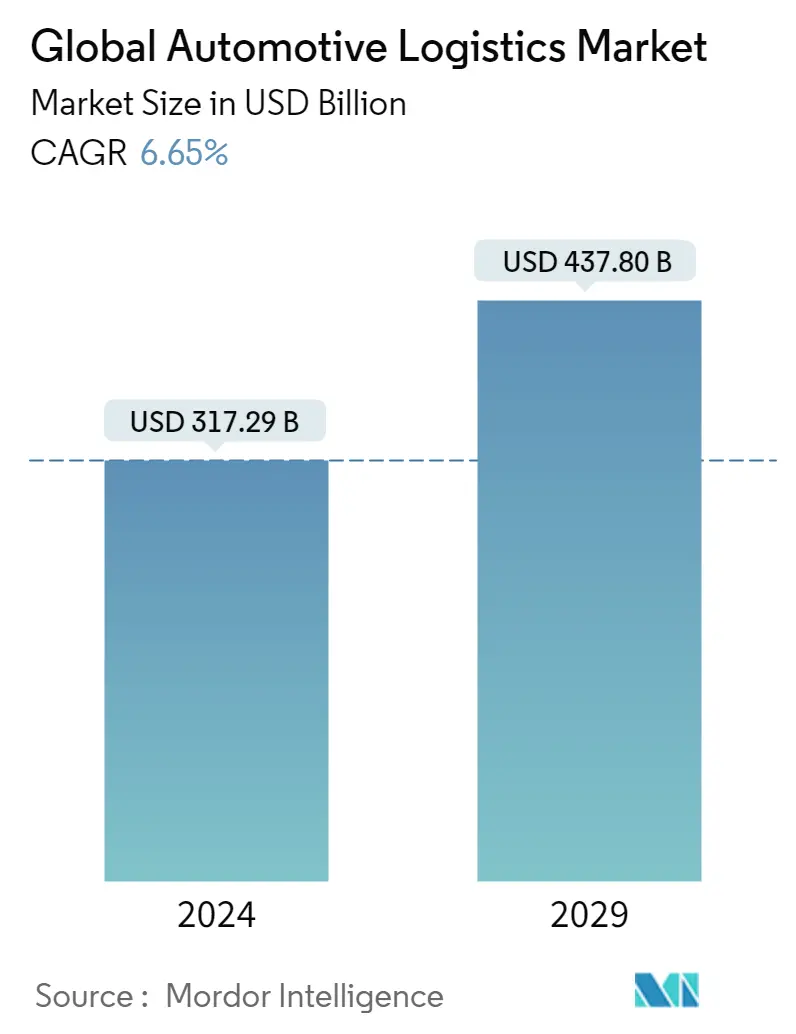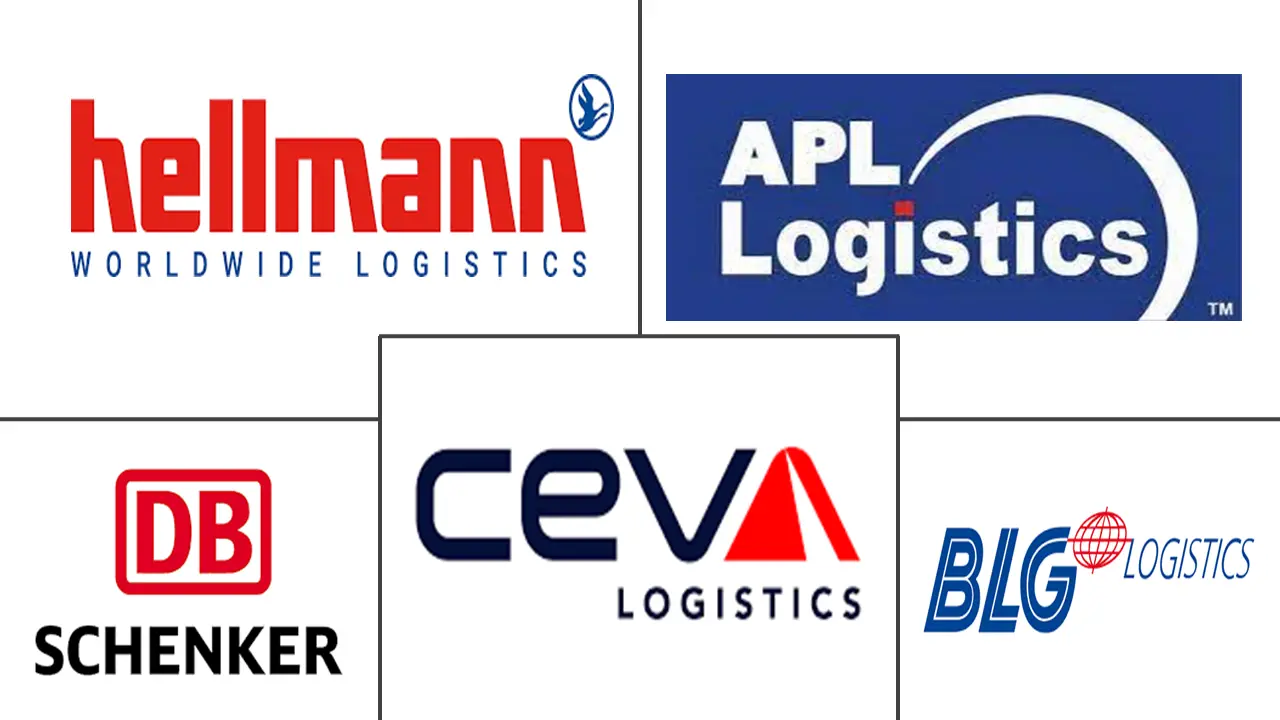Market Size of Global Automotive Logistics Industry

| Study Period | 2020 - 2029 |
| Market Size (2024) | USD 317.29 Billion |
| Market Size (2029) | USD 437.80 Billion |
| CAGR (2024 - 2029) | 6.65 % |
| Fastest Growing Market | Asia-Pacific |
| Largest Market | Asia-Pacific |
| Market Concentration | Low |
Major Players
*Disclaimer: Major Players sorted in no particular order |
Automotive Logistics Market Analysis
The Global Automotive Logistics Market size is estimated at USD 317.29 billion in 2024, and is expected to reach USD 437.80 billion by 2029, growing at a CAGR of 6.65% during the forecast period (2024-2029).
The COVID-19 problem has significantly impacted numerous industries, including tourism, healthcare, and retail. Due to the pandemic's extensive disruption of its supply chain, the automotive industry has also been severely impacted. The health issue continues to significantly influence the automotive industry despite a gradual lifting of government restrictions. With the automotive industry continually evolving, logistics are getting complex. Automotive companies are looking toward supply chain strategies to exploit new market opportunities, reduce costs, and maintain competitive advantage.
- Additionally, the introduction of electric vehicles is projected to offer a key uplift to the global automotive logistics market. The players operating in the logistics industry also offer warehousing and inventory management services to OEMs and Tier I and Tier II component manufacturers. The demand for these services depends on vehicle production.
- Hence, the regions with more vehicle production are likely to have a significant share in the automotive warehousing sector. In addition to warehousing and distribution, logistics service providers (LSPs) also offer assembly services for OEMs.
- Global car makers are disrupting the traditional supply chain with innovative transport solutions. For instance, in January 2019, Renault announced plans to start a home delivery service in Russia for vehicles sold via its online showroom. Promoting the online showroom is part of Renault's sales development strategy in Russia. It has already sold 27,000 finished vehicles via the site, primarily Renault Kaptur and Renault Duster units.
- While roll-on/roll-off (ro-ro) is the traditional method of shipping finished vehicles, containerization is becoming increasingly viable as the automotive industry decentralizes and introduces more EVs. Growth in China and Southeast Asia offers shipping and logistics companies good opportunities.
- Furthermore, the use of containers on developing routes out of China is also being adopted, especially by rail between China and Europe. Southeast Asia is considered one of the favorable regions to make containerization feasible, as the region witnesses growth in vehicle sales and demand for logistics services.
- Following the free trade agreement signed in the ASEAN markets, including the Philippines, Malaysia, Thailand, Vietnam, and Cambodia, trade-in finished vehicles has grown. CFR Rinkens, a vehicle transportation service provider, won a contract to ship BMWs from Europe to Vietnam in containers.
Automotive Logistics Industry Segmentation
The thorough planning and execution of a challenging vehicle transportation operation are known as automotive logistics. It includes all forms of transportation, including trucking, rail, and maritime.
A complete background analysis of the global automotive logistics market, which includes an assessment and contribution of the sector in the economy, market overview, market size estimation for key segments, key countries and emerging trends in the market segments, market dynamics, and key component flow statistics are covered in the report.
The global automotive logistics market is segmented by service (transportation, warehousing, distribution, inventory management, and other services), by type (finished vehicle, auto components, and other types), and by geography (Asia-Pacific, North America, Europe, Latin America, and the Middle East and Africa). The report offers market size and forecasts in values (USD billion) for all the above segments.
| By Service | |
| Transportation | |
| Warehousing, Distribution, and Inventory Management | |
| Other Services |
| By Type | |
| Finished Vehicle | |
| Auto Components | |
| Other Types |
| Geography | ||||||||
| ||||||||
| ||||||||
| ||||||||
| ||||||||
|
Global Automotive Logistics Market Size Summary
The automotive logistics market is poised for significant growth, driven by the evolving dynamics of the automotive industry and the increasing complexity of supply chains. The market is experiencing a transformation due to the rise of electric vehicles and the need for innovative logistics solutions. Companies in the logistics sector are expanding their offerings to include warehousing, inventory management, and assembly services to meet the demands of OEMs and component manufacturers. The shift towards containerization and the development of new routes, particularly in Asia-Pacific, are reshaping traditional shipping methods. This region, with its burgeoning vehicle production and favorable trade agreements, is expected to hold a substantial share of the market. Global logistics players are strategically entering this region to capitalize on the growth opportunities presented by emerging economies like China and India.
Despite challenges such as the COVID-19 pandemic and semiconductor shortages, the automotive logistics market is recovering and adapting to new trends. The market is characterized by a mix of large global players and smaller local entities, all vying for a share of the growing demand for logistics services. Companies are focusing on enhancing their capabilities in inventory handling and technology to differentiate their offerings. The increasing integration of e-commerce is also influencing logistics strategies, creating both opportunities and challenges. Major players in the industry are investing in advanced technologies and expanding their networks to optimize supply chains. The market's fragmented nature allows for intense competition, with third-party logistics providers offering value-added services to meet the diverse needs of manufacturers, retailers, and dealers.
Global Automotive Logistics Market Size - Table of Contents
-
1. MARKET INSIGHTS
-
1.1 Current Market Scenario
-
1.2 Industry Value Chain Analysis
-
1.3 Government Regulations and Initiatives
-
1.4 Global Logistics Sector (Overview, LPI Scores, Key Freight Statistics, etc.)
-
1.5 Focus on the Global Automotive Industry (Overview, Development and Trends, Statistics, etc.)
-
1.6 Spotlight - Effect of E-commerce on Traditional Automotive Logistics Supply Chain
-
1.7 Review and Commentary on Reverse Logistics (Overview, Challenges in Comparison with Forwards Logistics, etc.)
-
1.8 Insights on Automotive Aftermarket and its Logistics Activities
-
1.9 Spotlight on the Demand for Contract Logistics and Integrated Logistics
-
1.10 Impact of COVID 19 on Automotive Logistics Market
-
-
2. MARKET SEGMENTATION
-
2.1 By Service
-
2.1.1 Transportation
-
2.1.2 Warehousing, Distribution, and Inventory Management
-
2.1.3 Other Services
-
-
2.2 By Type
-
2.2.1 Finished Vehicle
-
2.2.2 Auto Components
-
2.2.3 Other Types
-
-
2.3 Geography
-
2.3.1 Asia-Pacific
-
2.3.1.1 China
-
2.3.1.2 Japan
-
2.3.1.3 India
-
2.3.1.4 South Korea
-
2.3.1.5 Rest of Asia-Pacific
-
-
2.3.2 North America
-
2.3.2.1 United States
-
2.3.2.2 Canada
-
2.3.2.3 Mexico
-
-
2.3.3 Europe
-
2.3.3.1 United Kingdom
-
2.3.3.2 Germany
-
2.3.3.3 Italy
-
2.3.3.4 Russia
-
2.3.3.5 France
-
2.3.3.6 Rest of Europe
-
-
2.3.4 Latin America
-
2.3.4.1 Brazil
-
2.3.4.2 Argentina
-
2.3.4.3 Rest of Latin America
-
-
2.3.5 Middle East & Africa
-
2.3.5.1 South Africa
-
2.3.5.2 United Arab Emirates
-
2.3.5.3 Saudi Arabia
-
2.3.5.4 Rest of Middle East & Africa
-
-
-
Global Automotive Logistics Market Size FAQs
How big is the Global Automotive Logistics Market?
The Global Automotive Logistics Market size is expected to reach USD 317.29 billion in 2024 and grow at a CAGR of 6.65% to reach USD 437.80 billion by 2029.
What is the current Global Automotive Logistics Market size?
In 2024, the Global Automotive Logistics Market size is expected to reach USD 317.29 billion.

